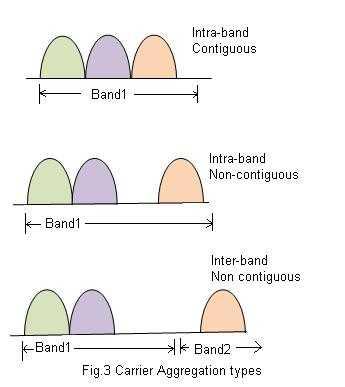5G NR Carrier Aggregation (CA) Basics
Advertisement
This page explains the fundamentals of 5G NR Carrier Aggregation (CA), including the frequency bands used for Carrier Aggregation/Dual Connectivity in LTE and 5G NR. It also discusses the advantages of carrier aggregation in wireless systems, such as 5G NR, and the minimum requirements for carrier aggregation in 5G NR.
Introduction to Carrier Aggregation
- The concept of CA was introduced in LTE Release-10.
- Carrier aggregation involves combining multiple carriers to increase bandwidth and, consequently, the data rate of the system.
- LTE R-10 supports up to 5 Component Carriers (CCs).
- LTE supports five bandwidth options: 1.4, 3, 5, 10, and 20 MHz. With a maximum bandwidth and 5 CCs, LTE can achieve a maximum bandwidth of 100 MHz. LTE R-13 (LTE Advanced-PRO) supports 32 CCs, potentially reaching 640 MHz.
- 5G NR supports carrier aggregation with up to 16 CCs.
- Carrier aggregation of LTE and 5G NR carriers is also possible, known as Dual Connectivity (DC).
- As the name suggests, Carrier Aggregation (CA) aggregates two or more Component Carriers (CCs).
- A UE can simultaneously receive or transmit on one or multiple CCs, depending on its capabilities.
- CA is supported for both contiguous and non-contiguous CCs.
- When CA is deployed, frame timing and SFN are aligned across cells that can be aggregated.

Figure 1 illustrates the three main types of carrier aggregation:
- Intra-band contiguous
- Intra-band non-contiguous
- Inter-band non-contiguous
5G NR Carrier Aggregation

- In 5G NR Phase-1, up to 16 CCs (both contiguous and non-contiguous) can be aggregated.
- Up to 1 GHz of spectrum can be aggregated.
- Carriers can use different numerologies (i.e., SCS, slots, etc.).
- Transport block mapping is performed on a per-carrier basis.
- Cross-carrier scheduling and joint feedback are supported.
- Carrier aggregation in 5G NR is used for both FR1 (below 6 GHz) and FR2 (above 6 GHz in the mmWave range) frequency bands.
Minimum Requirements of Carrier Aggregation in 5G NR
The following tables outline the minimum requirements for carrier aggregation in intra-band and inter-band modes. These requirements are derived from 3GPP TS 38.133.



Dual Connectivity | LTE and 5G NR Carrier Aggregation Frequency Bands
In Dual Connectivity carrier aggregation mode, both LTE and 5G NR carriers are combined. The frequency bands used for this are shown in the table below.

Advantages of Carrier Aggregation
- Increased bandwidth leads to higher data rates or throughput for both uplink and downlink.
- Network operators have the flexibility to deploy any of the three CA types.
- Facilitates the aggregation of licensed and unlicensed spectrums.
- Applicable to both TDD and FDD topologies.
- Improves network efficiency.
Advertisement
 RF
RF



